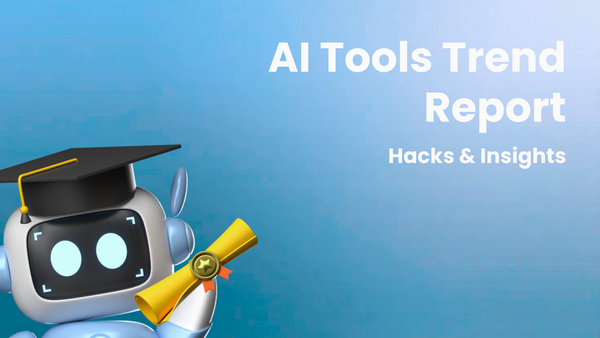Guide to AI Tools: How Buyer Behavior Shapes Your Choices

The AI Tool Compass: Navigating Buyer Behavior to Chart Your Course
Imagine launching a meticulously crafted marketing campaign, only to see it fall flat. The culprit? A disconnect between your chosen AI tools and the ever-evolving landscape of buyer behavior. Many businesses invest heavily in cutting-edge AI solutions, assuming that technology alone will guarantee success. But the truth is, AI tools are only as effective as your understanding of the customer they are meant to serve.
This disconnect leads to wasted resources, missed opportunities, and ultimately, a failure to achieve desired business outcomes. This article serves as your compass, guiding you through the complex terrain of AI tools and buyer behavior. We'll delve into how understanding your customers' needs, preferences, and decision-making processes can inform your AI tool selection, implementation, and ultimately, drive meaningful results. You'll learn how to leverage AI not just as a technological solution, but as a strategic enabler of customer-centricity, ensuring that your investments translate into tangible growth and improved customer experiences.
I. Decoding the AI-Buyer Behavior Nexus
AI, in its essence, automates tasks and gleans insights from data. But its true power lies in its ability to personalize experiences and predict future behavior. By understanding the principles behind AI and its application to buyer behavior, businesses can develop strategies to cater to the dynamic needs of their customers and improve their business outcomes.
A. The Genesis of Data-Driven Decision Making
The journey to understanding AI's role in buyer behavior starts with recognizing the shift from intuition-based marketing to data-driven strategies. Historically, marketing decisions were often based on gut feeling and limited market research. However, the advent of big data and advanced analytics paved the way for a more scientific approach.
Example: Before the rise of e-commerce and sophisticated data tracking, retailers relied on anecdotal evidence and limited demographics to understand customer preferences. Now, they can track every click, purchase, and interaction, building a detailed profile of each individual customer.
B. Defining the AI Landscape
Artificial intelligence encompasses a broad range of technologies, each designed to tackle specific challenges. Here's a brief overview of some key AI categories relevant to buyer behavior:
- Machine Learning (ML): Algorithms that learn from data without explicit programming, enabling predictive modeling and personalization.
- Natural Language Processing (NLP): AI's ability to understand and process human language, crucial for sentiment analysis, chatbot interactions, and content generation.
- Predictive Analytics: Using historical data to forecast future trends and behaviors, allowing for proactive decision-making.
- Computer Vision: Enabling machines to "see" and interpret images, opening possibilities for visual search, product recognition, and enhanced customer experiences.
C. Why Buyer Behavior Matters in the AI Equation
The most advanced AI tool is useless if it's not aligned with how your target audience behaves. Understanding your customer's journey, motivations, and pain points is paramount. AI should be seen as a tool to augment this understanding, not replace it.
Example: A company selling luxury watches might invest in an AI-powered recommendation engine. However, if the algorithm recommends budget-friendly options based solely on past purchase history, it misses the mark. Understanding the buyer's motivation (status, craftsmanship, investment) is crucial for effective recommendations.
D. The Downside of Ignoring Behavioral Nuances
Without a solid understanding of buyer behavior, AI initiatives can backfire. Personalization can become intrusive, recommendations irrelevant, and marketing messages tone-deaf.
Example: Imagine a customer purchasing a product as a gift. If they are bombarded with retargeting ads for that same product, it creates a negative and frustrating experience. AI must be used with a nuanced understanding of context.
II. Unveiling the Layers of Buyer Behavior: Guiding Your AI Selection
Understanding the specific components of buyer behavior is the key to choosing the right AI tools and applying them effectively.
A. Mapping the Customer Journey
The customer journey is the path a customer takes from initial awareness to post-purchase engagement. Understanding each stage allows you to pinpoint where AI can have the greatest impact.
- Awareness: How do customers discover your brand? (SEO, social media, advertising)
- Consideration: What factors influence their decision? (Reviews, price, features)
- Decision: What triggers the final purchase? (Promotions, urgency, trust)
- Retention: How do you keep them coming back? (Loyalty programs, personalized communication, customer support)
AI Application:
- Awareness: AI-powered SEO tools to optimize content for search engines; sentiment analysis to monitor brand mentions on social media.
- Consideration: AI-driven chatbots to answer questions; personalized content recommendations to address specific needs.
- Decision: Predictive analytics to identify customers likely to convert; AI-powered pricing optimization to offer competitive deals.
- Retention: AI-powered email marketing to send personalized offers; predictive analytics to identify customers at risk of churn.
B. Segmenting Your Audience
Not all customers are created equal. Segmentation involves dividing your audience into distinct groups based on shared characteristics.
- Demographics: Age, gender, location, income.
- Psychographics: Values, interests, lifestyle.
- Behavioral: Purchase history, website activity, engagement with marketing campaigns.
AI Application:
- Clustering algorithms can automatically identify customer segments based on behavioral data.
- Personalized content recommendation engines can tailor content to the specific interests of each segment.
- Targeted advertising campaigns can deliver the right message to the right audience.
Example: A fitness app might segment users based on their fitness goals (weight loss, muscle gain, endurance training). AI can then personalize workout recommendations and nutritional advice to each segment.
C. Uncovering Motivations and Pain Points
Understanding why customers buy is just as important as knowing what they buy. What problems are they trying to solve? What needs are they trying to fulfill?
AI Application:
- Sentiment analysis can analyze customer reviews and social media posts to identify common pain points.
- Natural Language Processing (NLP) can analyze customer support tickets and chat logs to understand the reasons behind customer complaints.
- AI-powered surveys can use adaptive questioning to uncover deeper insights into customer motivations.
Example: A software company might use NLP to analyze customer support tickets and discover that many users are struggling with a particular feature. This insight can then be used to improve the user interface or create more helpful documentation.
D. Predicting Future Behavior
Predictive analytics uses historical data to forecast future trends and behaviors. This allows businesses to proactively address customer needs and anticipate market changes.
AI Application:
- Churn prediction models can identify customers at risk of leaving.
- Demand forecasting algorithms can predict future sales based on past performance.
- Lead scoring models can identify the most promising leads for sales teams to focus on.
Example: An e-commerce company might use a churn prediction model to identify customers who haven't made a purchase in a while and are at risk of leaving. They can then proactively send them a personalized offer to entice them back.
III. AI Tools in Action: Case Studies and Practical Applications
Let's examine specific AI tools and how they can be leveraged to address common buyer behavior challenges.
A. Personalization Engines: Tailoring the Experience
Personalization engines use machine learning to deliver personalized content, recommendations, and offers to individual customers.
- Challenge: Customers are bombarded with generic marketing messages and irrelevant product recommendations.
- AI Solution: Personalization engines analyze customer data (purchase history, browsing behavior, demographics) to deliver targeted experiences.
- Example: Netflix uses a sophisticated recommendation engine to suggest movies and TV shows based on viewers' past viewing habits. This has significantly increased engagement and reduced churn.
B. Chatbots: Providing Instant Support
Chatbots use natural language processing to provide instant customer support and answer frequently asked questions.
- Challenge: Customers are frustrated with long wait times for customer support.
- AI Solution: Chatbots provide 24/7 support, freeing up human agents to focus on more complex issues.
- Example: Many e-commerce companies use chatbots to answer common questions about shipping, returns, and product availability. These chatbots can also guide customers through the purchase process and provide personalized recommendations.
C. Predictive Analytics: Anticipating Customer Needs
Predictive analytics uses historical data to forecast future trends and behaviors, allowing businesses to proactively address customer needs.
- Challenge: Businesses struggle to anticipate customer demand and manage inventory effectively.
- AI Solution: Predictive analytics can forecast demand based on past sales data, seasonal trends, and external factors.
- Example: Amazon uses predictive analytics to anticipate customer demand and optimize its inventory levels. This allows them to deliver products quickly and efficiently, minimizing stockouts and reducing storage costs.
D. Sentiment Analysis: Gauging Customer Emotions
Sentiment analysis uses natural language processing to analyze customer reviews, social media posts, and other forms of text data to understand customer sentiment.
- Challenge: Businesses struggle to understand how customers feel about their products and services.
- AI Solution: Sentiment analysis can identify negative feedback and alert businesses to potential problems.
- Example: A restaurant chain might use sentiment analysis to monitor online reviews and identify restaurants with consistently negative feedback. This information can then be used to improve service quality and address customer complaints.
E. AI-Powered Pricing Optimization
These tools leverage machine learning to dynamically adjust prices based on demand, competition, and customer behavior.
- Challenge: Setting optimal prices can be complex, requiring constant monitoring of market conditions and competitor pricing.
- AI Solution: AI algorithms analyze vast datasets to identify the price points that maximize revenue and profitability.
- Example: Airlines and hotels have long used dynamic pricing, but AI is making it accessible to smaller businesses. An online retailer might use AI to automatically adjust prices based on competitor pricing and customer demand, ensuring they remain competitive while maximizing profit margins.
IV. Navigating the Ethical and Practical Challenges of AI in Buyer Behavior
While AI offers tremendous potential, it's crucial to address the ethical considerations and practical challenges that come with its implementation.
A. Data Privacy and Security
- Challenge: Customers are increasingly concerned about the privacy and security of their data.
- Solution: Businesses must be transparent about how they collect and use customer data. They must also implement robust security measures to protect data from unauthorized access.
- GDPR and CCPA: Adhering to regulations like the General Data Protection Regulation (GDPR) and the California Consumer Privacy Act (CCPA) is paramount. These regulations mandate transparency and give consumers control over their personal data.
B. Bias and Fairness
- Challenge: AI algorithms can perpetuate existing biases if they are trained on biased data.
- Solution: Businesses must carefully vet their data to ensure that it is representative and unbiased. They should also monitor their AI algorithms for potential bias and take steps to mitigate it.
- Algorithmic Auditing: Regularly audit AI algorithms to identify and correct biases. This involves examining the data used to train the algorithm and the algorithm's output to ensure fairness across different demographic groups.
C. Transparency and Explainability
- Challenge: AI algorithms can be opaque, making it difficult to understand how they arrive at their decisions.
- Solution: Businesses should strive to make their AI algorithms more transparent and explainable. This will help build trust with customers and allow them to understand why they are seeing certain recommendations or offers.
- Explainable AI (XAI): Invest in XAI techniques that provide insights into how AI models reach their conclusions. This can help build trust and enable better decision-making.
D. The "Creepiness Factor"
- Challenge: Overly personalized marketing can feel intrusive and creepy.
- Solution: Businesses must strike a balance between personalization and privacy. They should avoid using data in ways that are unexpected or intrusive.
- Contextual Awareness: Ensure AI considers the context of customer interactions. Sending reminders about a product a customer has already purchased or offering discounts on items they've explicitly stated they're not interested in can be perceived as intrusive.
E. Skills Gap and Implementation Costs
- Challenge: Implementing and managing AI tools requires specialized skills and can be expensive.
- Solution: Invest in training and development to build internal AI expertise. Start with small-scale projects and gradually scale up as you gain experience. Consider partnering with AI vendors to leverage their expertise and resources.
- Start Small, Scale Smart: Avoid large-scale implementations that can overwhelm your team and budget. Begin with pilot projects focused on specific areas, such as personalized recommendations or chatbot support, and expand as you see results.
V. Charting Your AI Course: A Practical Guide to Implementation
Here's a step-by-step guide to integrating AI into your business while keeping buyer behavior at the forefront:
Step 1: Define Your Objectives
What specific business goals are you trying to achieve with AI? (e.g., increase sales, improve customer satisfaction, reduce churn).
Step 2: Understand Your Customer
Conduct thorough research to understand your customer's journey, motivations, and pain points.
Step 3: Select the Right AI Tools
Choose AI tools that are aligned with your objectives and your understanding of customer behavior.
Step 4: Integrate AI into Your Existing Systems
Ensure that your AI tools are seamlessly integrated with your existing CRM, marketing automation, and other systems.
Step 5: Monitor and Optimize
Continuously monitor the performance of your AI tools and make adjustments as needed.
Step 6: Prioritize Ethical Considerations
Adhere to data privacy regulations and address potential biases in your AI algorithms.
Step 7: Train Your Team
Ensure that your team has the skills and knowledge to effectively use and manage AI tools.
Actionable Checklist:
- [ ] Clearly define your business objectives.
- [ ] Conduct thorough customer research (surveys, interviews, data analysis).
- [ ] Map the customer journey.
- [ ] Identify key touchpoints for AI intervention.
- [ ] Select AI tools that align with your objectives and customer needs.
- [ ] Develop a data privacy policy.
- [ ] Train your team on AI tools and ethical considerations.
- [ ] Establish metrics for measuring AI performance.
- [ ] Regularly monitor and optimize your AI implementations.
VI. Conclusion: The Future of AI and Buyer Behavior
AI is rapidly transforming the way businesses interact with customers. By understanding buyer behavior and leveraging AI tools strategically, businesses can create more personalized, engaging, and effective customer experiences. However, it's crucial to remember that AI is not a magic bullet. It's a powerful tool that must be used responsibly and ethically.
As AI continues to evolve, the lines between technology and human interaction will become increasingly blurred. The companies that succeed will be those that can seamlessly integrate AI into their business processes while maintaining a human-centric approach. The key is to view AI not as a replacement for human intelligence, but as a powerful augmentation tool that empowers businesses to better understand and serve their customers.
Call to Action: Take a moment to reflect on your current AI strategy. Are you truly leveraging AI to understand and address the needs of your customers? Identify one actionable step you can take today to improve your AI implementation and create a more customer-centric experience. Consider revisiting your customer journey map and identifying one point where AI can meaningfully enhance the customer experience. Then, research an AI tool that addresses that specific need and begin exploring its potential for your business. The future of business is personalized, and by aligning your AI efforts with a deep understanding of buyer behavior, you can position your company for long-term success.




